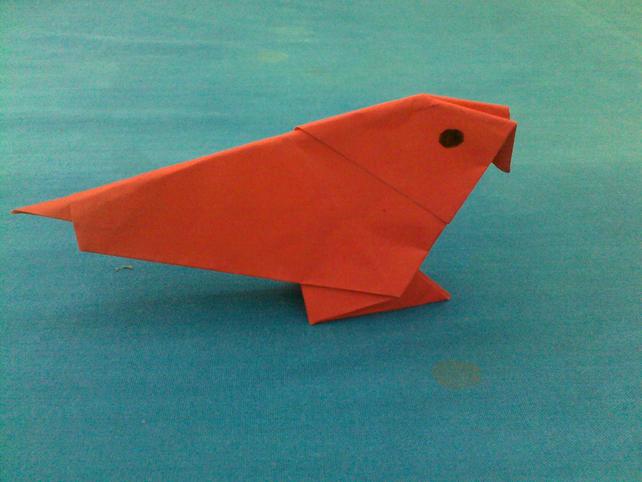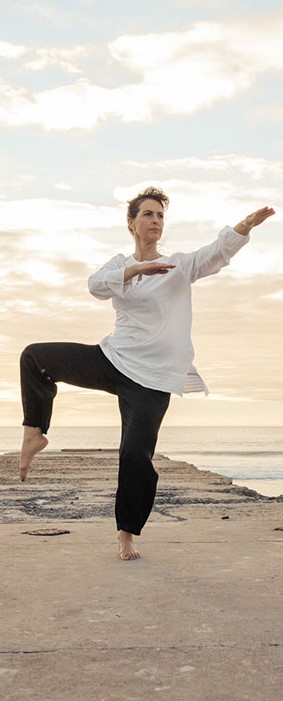STRUCTURE
OUTLINE
- Theatre Games
- Phonics and Grammar
- Improvisations and Dialogues
- Word games and Songs
- Origami and Art Projects
The exercises alternate every fifteen minutes or so from active to passive and back again, with a recess every half hour. This will keep the attention of the group, gravitating between the physical and the mental.
This active-passive method can be adapted to any subject, and I found it to be excellent teaching ESL. It gives students time to assimilate what was previously learned and the opportunity to put this new knowledge into action.
I prefer to have the desks in a circle. It's a change from the other classes and gives us space for the active exercises. I encourage students to lead. The following sample is for one hour, to learn English.
Origami teaches to be precise
Start the class the same manner
There are several reasons for this. It's a ritual that prepares students mentally for the session, and puts students in a condition to follow the rules.
Cross movements are meant to stimulate the learning process by coordinating opposing sides of the body. Neuroscientists maintain that cross-body movements help the left and right hemispheres of the brain to connect, which activates something that makes it easier to learn. I begin the session with these exercises. They also get rid of excess energy and how strenuous I make them depends on the class.
Eventually I go into slow, made up tai-chi movements, and invite students to lead. It has to be slow.
The change in energy levels is helpful with youth in the United States, where the attention span is low, I believe it's because of programs on television continuously interrupted by commercials.
You can gradually increase the time span, especially if you plan a class performance.
THEATRE GAMES
The lesson begins with a theatre game. There are sixteen games to choose from in the Theatre Games link.
The Mediator
The first game on the list is by Augusto Boal, arguably the most important of all, where participants act out the Bully, the Victim, and the Mediator. Which of the three would you rather be? I'd have students do this often during the year followed by improvisations. In how many ways can one react to a conflict?
_________________________
PHONICS
ONE
Begin with breathing exercises: breath deeply into the stomach, inhale through your nose and exhale slowly through the mouth. Breath in deeply, and blow on an imaginary candle so the "flame" flickers but does not extinguish.
TWO
Ask students to use all the mouth, face and neck muscles while they say, without pausing between the letters...
aaaeeeeeiiiiioooouuuuaaaaeeeeiiiiioooouuuu...
Pause between letters so they come out like gunshots: A! E! I! O! U! A! E! I!
THREE
Take a deep breath, say the vowels in a whisper. Urgent, pausing between each vowel. From a whisper go louder, and back to an urgent whisper. A students can lead (the hand up is high, the hand down is low, slowly!).
Make sure there is the same energy level and voice control at the end.
IRREGULAR VERBS
The same exercises as in Phonics, except with irregular verbs.
To do - To run - To see
ONE
Like a drumbeat: Do. Did. Done. Then all together, with the emphasis at the end: dodiddone-dodiddone....Then as gunshots: Do! Did! Done! Do! Did! Done! Do! Did! Done!... Low to high, and so forth as in the Phonics exercises.
TWO
When all three verbs have been practiced put them together: They can be read.
Do! Did! Done! Run! Ran! Run! See! Saw! Seen! Do! Did! Done! ...
IMPROVISATIONS
ONE
Place the emphasis on the different words in a sentence
What did you do? What did you do? What did you do? What did you do?
Surprised, angry, pleased, confused?
TWO
The advantage in this exercise in mime is attention to details.
Each exercise is a little more complicated.
- As a group, pull on a rope hanging from the ceiling, reach up high, grab the rope and pull down, one hand over the other, in slow motion. Ask the group to express tension so the audience can "feel" the effort of pulling down.
- Make certain to pull straight down, and to leave space in the hand for the rope, not just clench the fingers. Put a foot over the rope on the ground so it won't slide back up.
- You pull harder on the rope, look up and a huge blob is falling on your head. Slowly lower your body as you watch the blob get bigger and closer.
- Singly. Walk to your house, find your keys and open the door. Make sure the door is completely open before crossing, close the door. Put the keys on the table.
- Go to your car. Find the keys, unlock the door, open the door...
- You can't find the keys, retrace your steps...
The movements should be slightly exaggerated and not too fast. Make use of pauses. Remind students they are not really opening a door or pulling a rope, just making the audience believe they are. The audience needs time to assimilate.
THREE
.- Students can only respond with a question. The one who makes the mistake is replaced by another student. Though it's a challenging exercise, it's also funny. The audience is encouraged to help the two students onstage with ideas on how to respond.
The objective is to think outside the box. The instinct is to reply to a question, however, one can deviate by asking a random question. Pretend to be a private investigator.
- What are you doing here? - Is that your dog on the street? - Who was with you at the restaurant?
WORD GAMES
Invent tongue twisters
Pass the mustard, hold the custard, spill the salt, not my fault. It's Fred, she said.
You can put words that rhyme on the board and have students form groups
ART PROJECTS
LESSON PLAN
A word is nothing without an action to back it. What is important is how it's interpreted, it's intention.


